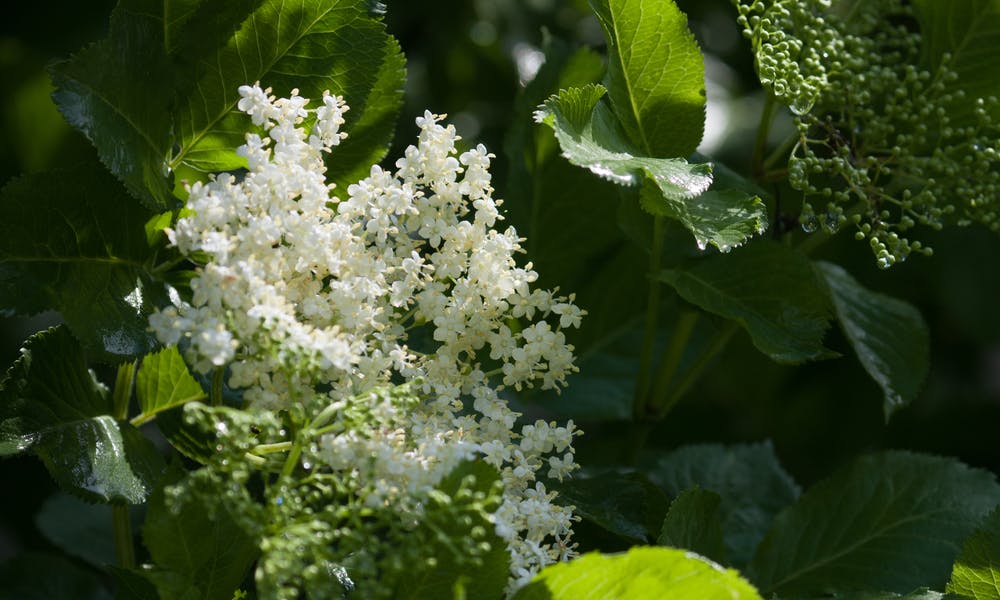MENU
Elder Flower: The Tasty Bloom

The elder flower is the flower of a deciduous shrub that is known all over the world, due to its aromatic flowers and its fruits. It is common to prepare delicious, cold beverages from the elder flower. Additionally, the elder fruits and flowers are used for the preparation of various foods.
The beneficial effects on the human body of these preparations are extremely popular. More than two dozen species are identified worldwide. The best known are the American elderberry (Sambucus Canadensis), the black elder (Sambucus nigra), the Mexican elder, the Asian dwarf elder, and the Red elder from Australia. So, if you like elder flower for its properties, check out the following sections:
* Origins and customs related to the elder flower
* What is the elder flower
* How to grow and care for the elder flower
* Uses of elder flower
Origins and Customs Related to The Elder Flower
The elder flower, scientifically called Sambucus canadensis, has its origins in North America and is known for its white-cream flowers in the form of clusters, from which people make a very tasty refreshing beverage. The elder is also known for its purple-black fruits, which are used to cure various diseases.
There are many superstitions and traditions related to the elder flower. This shrub is supposed to come from Great Britain, where it was grown like a hedge bush and it was shrouded in mystery.
Its white flowers and black fruits have been associated over time with a series of healing powers and properties. The elder flower shrub has long been regarded as a sacred tree, and the people of the country have long avoided cutting it out of fear. The shrub was considered the protector of the house that prevented evil spirits from entering. Furthermore, it was believed that you had to shelter beneath the elder tree if you wanted to be protected against electrical phenomena during storms.
What Is The Elder Flower?
The elder flower shrub comes from the family Adoxaceae or viburnum. Other botanists claim that the elder flower shrub comes from the family Caprifoliaceae or honeysuckle family. This shrub is found in many climatic zones. While Sambucus nigra is native from Europe, North Africa, and Western Asia, Sambucus canadensis is native to North and Central America.
Speaking of the American elderberry, you should note that the shrub has light brown or gray stems and can be easily dug out, so it could be used as tubes for collecting maple syrup.
Sambucus shrub has compound leaves, each leaf having five to nine oval leafy teeth. The shrub is perennial and the aromatic flowers appear in late spring or early summer. They are like umbrellas, creamy white, and they open from the outside to the inside. When harvesting, you should look for the flowers completely open in the center.
After it has been raining, wait for the sun to rise again, so the flowers get dry before harvesting them. If you harvest them wet, they change the color from cream white to black. The tasty purple-dark fruits can be harvested from August to the end of September.
How to Grow and Care for The Elder Flower
The American elder flower shrub can reach a height of 10 up to 15 feet. They are widespread in the wild and, therefore, they are not pretentious and can be very easily cultivated in your garden. They have a rounded leaf crown, add extra beauty and liveliness to your garden, because of the flowers that attract butterflies and the fruits that are loved by many birds.
Even though the American elderberry shrubs are not pretentious, we can give you some tips if you want a larger crop of fruits:
* It is ideal for these shrubs to be planted in a place where they can benefit from the sun as well as shade.
* The best soil for these shrubs is the slightly acidic one. They like the soil as moist as possible because the roots do not rot.
* Some types of elder flower can withstand a drought; in this case, it is best not to overwater them.
* Elder shrubs grow in different climates with different levels of temperature and humidity, but they do not like frost.
* Before planting them, you should add compost to the soil; annually, in the spring, you should fertilize the soil with supplementary compost.
* At the beginning of spring, you should trim your shrub. Remove the dead and damaged or diseased branches and aim to make a beautiful round crown.
* You can multiply your shrub by gathering seeds for germinating or by taking cuttings from mature plants.
* You have to remove the weeds from the root of the shrub, either manually or by covering the soil around the roots with tree bark.
Uses of Elder Flower
The medical benefits of elder flowers have been known since ancient times. In ancient Egypt, the cosmetic effects of elder flower juice were well-known for reducing wrinkles.
Later, in the 17th century, Martin Blochwich translated the book entitled “The Anatomy of Elder” from Latin and described in detail the beneficial effects of this plant for 70 diseases.
Nowadays, elderberry fruits are used in the preparation of jellies, jams, and elderberry tinctures, while elder flowers are used for a refreshing and foamy beverage. Elderflower can be used to flavor wine or beer or also for preparing the tea. They are also tasty in desserts, baked in the oven.
Elderflowers are also well-known for treating diseases such as sinusitis, colds, laryngitis, influenza, cough, and bacterial infection. The benefic effects of these flowers are popular among patients with diabetes.
To sum up, elder flowers come from a perennial shrub, which grows in the wild and can be easily planted. They add freshness to your garden and the fruits and flowers are a delight for your taste buds!

